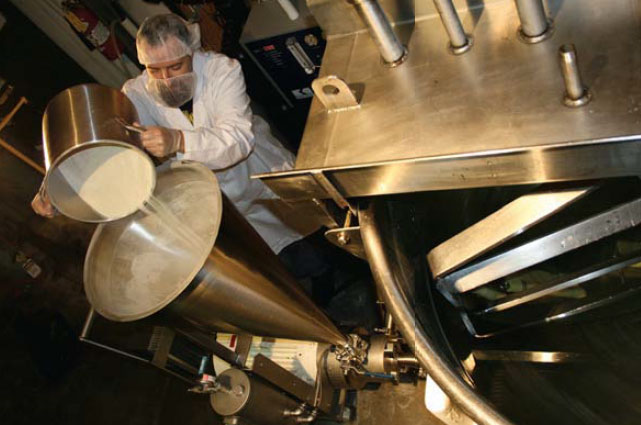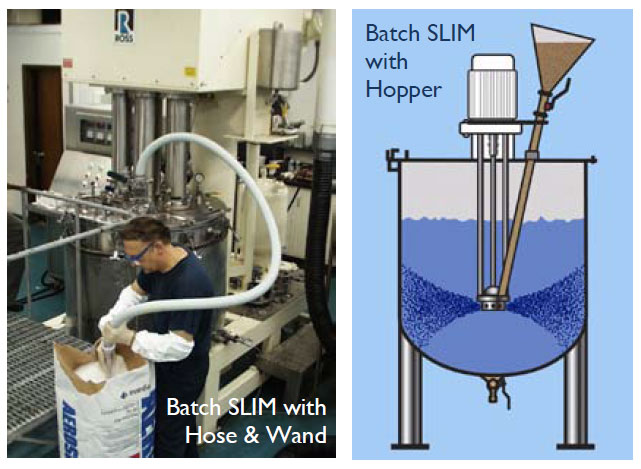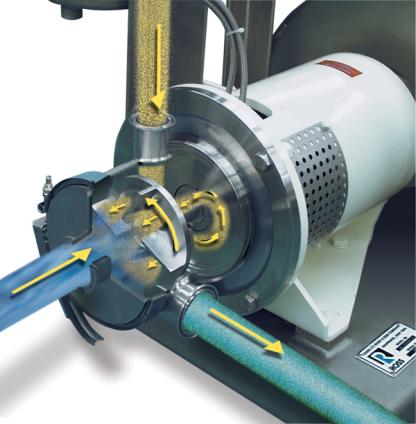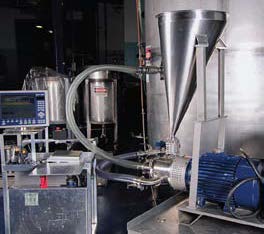Tech Report
Eliminate fish eyes in your mix

Technology Brief
Inefficient mixing can lead to agglomerates and "fish eyes" which are difficult to disperse once formed. Using a high shear mixer equipped for powder induction helps prevent the formation of agglomerates, maximizes yield and cuts cycle time.
Agglomerates and "fish eyes"
The dispersion of certain powdered solids such as xanthan gum, guar, carrageenan, carboxymethylcellulose (CMC), alginates and other thickeners into a liquid phase are particularly difficult because they resist wetting out. When mixed with a traditional turbine or paddle agitator in a kettle, they float stubbornly for hours on the surface of the batch. Even when processed using high speed mixing devices such as saw-tooth dispersers that generate a strong vortex on top of the batch, these powders may still take a long while to hydrate completely. Rather than break down and wet out, they often form agglomerates and "fish eyes", which are very difficult to break apart. "Fish eyes" are agglomerates of partially hydrated powders characterized by a tough outer layer which prevents the complete wetting of particles within the interior.
Scale-up mixing issues
On a laboratory scale, small batches can often be made using simple agitators because powders can be added at a very slow rate and because blade size and agitator power are easily oversized in a bench-top setting. In contrast, large-scale production of thickened solutions is not as easy to accomplish. Many operators are left to contend with carefully sifting and slowly adding powders into the batch. In extreme cases, solids are intentionally overdosed and the undispersed agglomerates are simply filtered out. This is done to keep cycle time within a reasonable period. In addition, when mixing is prolonged to break up lumps in the batch, it can overshear the already hydrated particles and result in a permanent viscosity loss.
Powder induction mixing technology
A mixing system equipped for powder induction prevents the formation of agglomerates and fish eyes in the first place. The Solids/Liquid Injection Manifold (SLIM) available on batch and inline Ross High Shear Mixers offers this functionality. In a SLIM mixer, a ported rotor and stator specially designed to generate a powerful vacuum draws powders directly into the high shear zone within the mix chamber, where they are instantly dispersed into the liquid. Because solids and liquids are combined and mixed simultaneously, the formation of agglomerates and fish eyes is prevented. The sub-surface addition of solids also eliminates the occurrence of floating powders.

Efficient, fast and repeatable dispersion method
Operation of a SLIM system is simple and straightforward - just turn on the mixer and start inducting powders. Attaching a "hose & wand" device to the powder inlet of the SLIM allows the operator to simply draw powders straight from within the bulk container.
Powders may also be loaded into a hopper and as soon as the mixer reaches operating speed, the SLIM valve is opened to allow the flow of solids into the shear-intense region within the rotor/stator assembly. Powders are quickly drawn into the batch via the powerful vacuum generated by the ported rotor.
How the SLIM technology works

The above illustration shows how an inline SLIM mixer works. The liquid stream (1) enters the mixer and immediately encounters the powder addition. Drawn into the mixer by a powerful vacuum, the powder (2) is injected through the ported rotor directly into the high shear zone. The resulting dispersion (3) is expelled centrifugally through the stator openings at high velocity.

SLIM Installation Snapshots:
In this installation, an inline SLIM mixer is connected to a 2,500-gal vessel for the production of food flavorings. Gums, flavors and other solid ingredients are charged into the SLIM hopper. The mixer is started which commences the recirculation of liquid from the tank, through the rotor/stator and back again. When the SLIM valve is opened, powders in the hopper are drawn into the liquid stream and dispersed instantly. At the end of the mix cycle, the SLIM mixer is flushed and moved to another vessel.
By switching from their previous turbine agitator system to the SLIM, the company was able to cut batch times sharply across the board - from 48 hours to eight hours in one case that involved a 5,000-lb batch, and from eight hours to three hours in another.